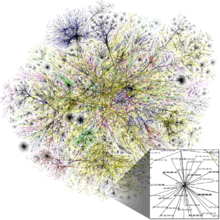Intergalactic Computer Network
- Not to be confused with Interplanetary Internet.
| Internet |
|---|
 An Opte Project visualization of routing paths through a portion of the Internet |
|
|
Intergalactic Computer Network or Galactic Network[1] was a computer networking concept similar to today's Internet.
J.C.R. Licklider, the first director of the Information Processing Techniques Office (IPTO) at The Pentagon's ARPA, used the term in the early 1960s to refer to a networking system he “imagined as an electronic commons open to all, ‘the main and essential medium of informational interaction for governments, institutions, corporations, and individuals.’”[2][3] An office memorandum he sent to his colleagues in 1963 was addressed to "Members and Affiliates of the Intergalactic Computer Network".[4] As head of IPTO from 1962 to 1964, “Licklider initiated three of the most important developments in information technology: the creation of computer science departments at several major universities, time-sharing, and networking.”[3]
By the late 1960s, his promotion of the concept had inspired a primitive version of his vision called ARPANET, which expanded into a network of networks in the 1970s that became the Internet.[2]
See also
References
- ↑ Leiner, Barry M.; et al. (2003-12-10). ""Origins of the Internet" in A Brief History of the Internet version 3.32". The Internet Society. Retrieved 2007-11-03.
- 1 2 Garreau, Joel (2006). Radical Evolution: The Promise and Peril of Enhancing Our Minds, Our Bodies--and what it Means to be Human. Broadway. p. 22. ISBN 978-0-7679-1503-8.
- 1 2 "Defense Advanced Research Projects Agency (DARPA) (United States Government)". Encyclopædia Britannica. Encyclopædia Britannica, Inc. Retrieved 11 January 2014.
- ↑ Licklider, J. C. R. (23 April 1963). "Topics for Discussion at the Forthcoming Meeting, Memorandum For: Members and Affiliates of the Intergalactic Computer Network". Washington, D.C.: Advanced Research Projects Agency, via KurzweilAI.net. Retrieved 2013-01-26.
Further reading
- Jones, Steve (2003). Encyclopedia of New Media. Sage Publications, via Google Books limited preview. p. 287. ISBN 0-7619-2382-9. Retrieved 2007-11-03.
- Page, Dan and Cynthia Lee (1999). "Looking Back at Start of a Revolution". UCLA Today. The Regents of the University of California (UC Regents). Archived from the original on 2007-12-24. Retrieved 2007-11-03.
- Hauben, Ronda (19 March 2001). "Draft for Comment 1.001, "The Information Processing Techniques Office and the Birth of the Internet"" (Microsoft Word). Retrieved 2007-11-03.